Known in English Bodhidharma Religion Buddhism Students Huike Books The Bodhidharma anthology | Chinese abbreviation 達摩 Siblings Kudoku Tara, Getsujo Tara | |
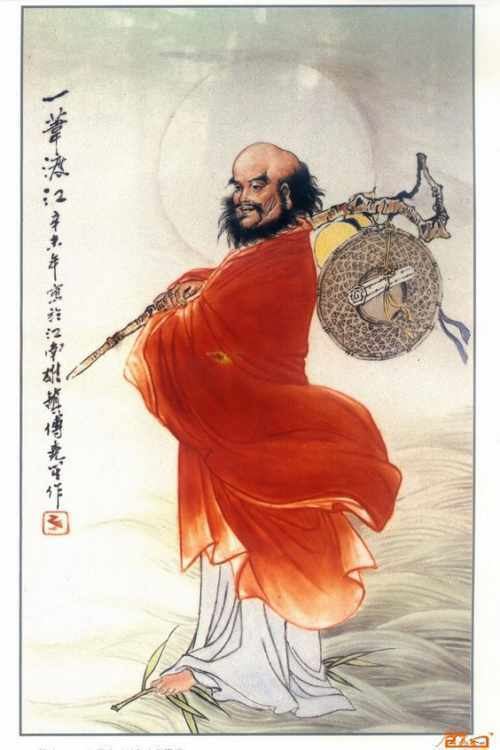 | ||
Similar Gautama Buddha, Dazu Huike, Huineng, Mahākāśyapa, Dōgen | ||
Bodhidharma was a Buddhist monk who lived during the 5th or 6th century. He is traditionally credited as the transmitter of Chan Buddhism to China, and regarded as its first Chinese patriarch. According to Chinese legend, he also began the physical training of the monks of Shaolin Monastery that led to the creation of Shaolin Kung Fu. In Japan, he is known as Daruma.
Contents
- Bodhidharma Founder of Zen from India to Shaolin
- Principal sources
- The Record of the Buddhist Monasteries of Luoyang
- Tnln preface to the Two Entrances and Four Acts
- Chronicle of the Lakvatra Masters
- Further Biographies of Eminent Monks
- Anthology of the Patriarchal Hall
- Doyun Transmission of the Lamp
- Popular traditions
- Legends about Bodhidharma
- Encounter with Emperor Xio Yn
- Nine years of wall gazing
- Huike cuts off his arm
- Skin flesh bone marrow
- Bodhidharma at Shaolin
- Travels in Southeast Asia
- Appearance after his death
- Practice and teaching
- Pointing directly to ones mind
- Wall gazing
- The Lakvatra Stra
- Construction of lineages
- Six patriarchs
- Continuous lineage from Gautama Buddha
- Modern scholarship
- Biography as a hagiographic process
- Origins and place of birth
- Caste
- Name
- Abode in China
- Shaolin boxing
- Works attributed to Bodhidharma
- Quotes
- References
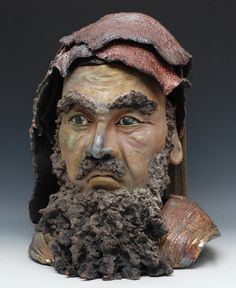
Little contemporary biographical information on Bodhidharma is extant, and subsequent accounts became layered with legend.
According to the principal Chinese sources, Bodhidharma came from the Western Regions, which refers to Central Asia but may also include the Indian subcontinent, and was either a "Persian Central Asian" or a "South Indian [...] the third son of a great Indian king." Throughout Buddhist art, Bodhidharma is depicted as an ill-tempered, profusely-bearded, wide-eyed non-Chinese person. He is referred as "The Blue-Eyed Barbarian" (Chinese: 碧眼胡; pinyin: Bìyǎnhú) in Chan texts.
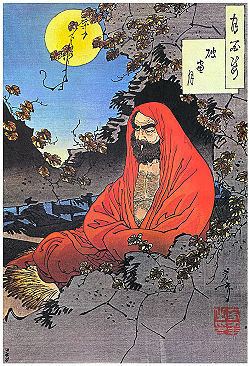
Aside from the Chinese accounts, several popular traditions also exist regarding Bodhidharma's origins.
The accounts also differ on the date of his arrival, with one early account claiming that he arrived during the Liu Song dynasty (420–479) and later accounts dating his arrival to the Liang dynasty (502–557). Bodhidharma was primarily active in the territory of the Northern Wei (386-634). Modern scholarship dates him to about the early 5th century.
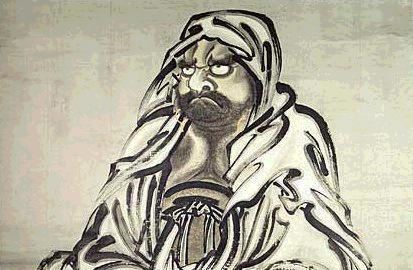
Bodhidharma's teachings and practice centered on meditation and the Laṅkāvatāra Sūtra. The Anthology of the Patriarchal Hall (952) identifies Bodhidharma as the 28th Patriarch of Buddhism in an uninterrupted line that extends all the way back to the Gautama Buddha himself.
Bodhidharma: Founder of Zen, from India to Shaolin
Principal sources
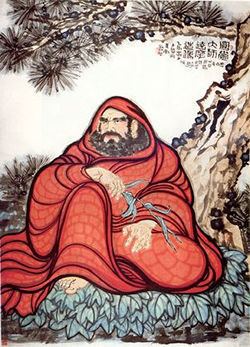
There are two known extant accounts written by contemporaries of Bodhidharma. According to these sources, Bodhidharma came from the Western Regions, and was either a "Persian Central Asian" or a "South Indian [...] the third son of a great Indian king." Later sources draw on these two sources, adding additional details, including a change to being descendent from a Brahmin king, which accords with the reign of the Pallavas, who were Brahmins.
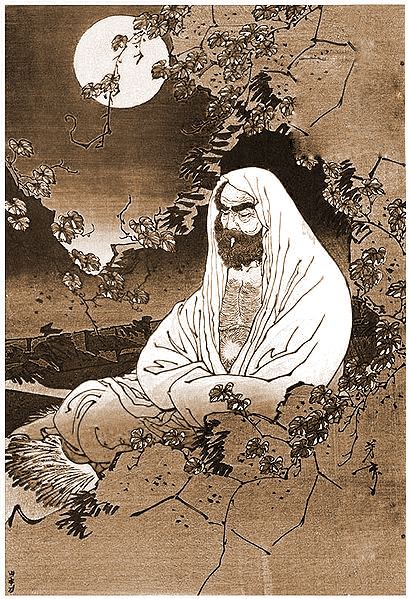
The Western Regions was a historical name specified in the Chinese chronicles between the 3rd century BC to the 8th century AD that referred to the regions west of Yumen Pass, most often Central Asia or sometimes more specifically the easternmost portion of it (e.g. Altishahr or the Tarim Basin in southern Xinjiang). Sometimes it was used more generally to refer to other regions to the west of China as well, such as the Indian subcontinent (as in the novel Journey to the West).
The Record of the Buddhist Monasteries of Luoyang
The earliest text mentioning Bodhidharma is The Record of the Buddhist Monasteries of Luoyang (Chinese: 洛陽伽藍記 Luòyáng Qiélánjì) which was compiled in 547 by Yáng Xuànzhī (楊衒之), a writer and translator of Mahayana sutras into Chinese. Yang gave the following account:
At that time there was a monk of the Western Region named Bodhidharma, a Persian Central Asian. He traveled from the wild borderlands to China. Seeing the golden disks on the pole on top of Yǒngníng's stupa reflecting in the sun, the rays of light illuminating the surface of the clouds, the jewel-bells on the stupa blowing in the wind, the echoes reverberating beyond the heavens, he sang its praises. He exclaimed: "Truly this is the work of spirits." He said: "I am 150 years old, and I have passed through numerous countries. There is virtually no country I have not visited. Even the distant Buddha-realms lack this." He chanted homage and placed his palms together in salutation for days on end.
Tánlín – preface to the Two Entrances and Four Acts
The second account was written by Tánlín (曇林; 506–574). Tánlín's brief biography of the "dharma Master" is found in his preface to the Long Scroll of the Treatise on the Two Entrances and Four Practices, a text traditionally attributed to Bodhidharma and the first text to identify him as South Indian:
The Dharma Master was a South Indian of the Western Region. He was the third son of a great Indian king. His ambition lay in the Mahayana path, and so he put aside his white layman's robe for the black robe of a monk […] Lamenting the decline of the true teaching in the outlands, he subsequently crossed distant mountains and seas, traveling about propagating the teaching in Han and Wei.
Tánlín's account was the first to mention that Bodhidharma attracted disciples, specifically mentioning Dàoyù (道育) and Dazu Huike (慧可), the latter of whom would later figure very prominently in the Bodhidharma literature. Although Tánlín has traditionally been considered a disciple of Bodhidharma, it is more likely that he was a student of Huìkě.
"Chronicle of the Laṅkāvatāra Masters"
Tanlin's preface has also been preserved in Jingjue's (683-750) Lengjie Shizi ji "Chronicle of the Laṅkāvatāra Masters", which dates from 713-716./ca. 715 He writes,
The teacher of the Dharma, who came from South India in the Western Regions, the third son of a great Brahman king."
"Further Biographies of Eminent Monks"
In the 7th-century historical work "Further Biographies of Eminent Monks" (續高僧傳 Xù gāosēng zhuàn), Dàoxuān (道宣; 596-667) possibly drew on Tanlin's preface as a basic source, but made several significant additions:
Firstly, Dàoxuān adds more detail concerning Bodhidharma's origins, writing that he was of "South Indian Brahman stock" (南天竺婆羅門種 nán tiānzhú póluómén zhŏng).
Secondly, more detail is provided concerning Bodhidharma's journeys. Tanlin's original is imprecise about Bodhidharma's travels, saying only that he "crossed distant mountains and seas" before arriving in Wei. Dàoxuān's account, however, implies "a specific itinerary": "He first arrived at Nan-yüeh during the Sung period. From there he turned north and came to the Kingdom of Wei" This implies that Bodhidharma had travelled to China by sea and that he had crossed over the Yangtze.
Thirdly, Dàoxuān suggests a date for Bodhidharma's arrival in China. He writes that Bodhidharma makes landfall in the time of the Song, thus making his arrival no later than the time of the Song's fall to the Southern Qi in 479.
Finally, Dàoxuān provides information concerning Bodhidharma's death. Bodhidharma, he writes, died at the banks of the Luo River, where he was interred by his disciple Dazu Huike, possibly in a cave. According to Dàoxuān's chronology, Bodhidharma's death must have occurred prior to 534, the date of the Northern Wei's fall, because Dazu Huike subsequently leaves Luoyang for Ye. Furthermore, citing the shore of the Luo River as the place of death might possibly suggest that Bodhidharma died in the mass executions at Heyin (河陰) in 528. Supporting this possibility is a report in the Chinese Buddhist canon stating that a Buddhist monk was among the victims at Héyīn.
Anthology of the Patriarchal Hall
In the Anthology of the Patriarchal Hall (祖堂集 Zǔtángjí) of 952, the elements of the traditional Bodhidharma story are in place. Bodhidharma is said to have been a disciple of Prajñātāra, thus establishing the latter as the 27th patriarch in India. After a three-year journey, Bodhidharma reached China in 527, during the Liang (as opposed to the Song in Dàoxuān's text). The Anthology of the Patriarchal Hall includes Bodhidharma's encounter with Emperor Wu of Liang, which was first recorded around 758 in the appendix to a text by Shenhui (神會), a disciple of Huineng.
Finally, as opposed to Daoxuan's figure of "over 180 years," the Anthology of the Patriarchal Hall states that Bodhidharma died at the age of 150. He was then buried on Mount Xionger (熊耳山 Xióngĕr Shān) to the west of Luoyang. However, three years after the burial, in the Pamir Mountains, Sòngyún (宋雲)—an official of one of the later Wei kingdoms—encountered Bodhidharma, who claimed to be returning to India and was carrying a single sandal. Bodhidharma predicted the death of Songyun's ruler, a prediction which was borne out upon the latter's return. Bodhidharma's tomb was then opened, and only a single sandal was found inside.
According to the Anthology of the Patriarchal Hall, Bodhidharma left the Liang court in 527 and relocated to Mount Song near Luoyang and the Shaolin Monastery, where he "faced a wall for nine years, not speaking for the entire time", his date of death can have been no earlier than 536. Moreover, his encounter with the Wei official indicates a date of death no later than 554, three years before the fall of the Western Wei.
Dàoyuán – Transmission of the Lamp
Subsequent to the Anthology of the Patriarchal Hall, the only dated addition to the biography of Bodhidharma is in the Jingde Records of the Transmission of the Lamp (景德傳燈錄 Jĭngdé chuándēng lù, published 1004 CE), by Dàoyuán (道原), in which it is stated that Bodhidharma's original name had been Bodhitāra but was changed by his master Prajñātāra. The same account is given by the Japanese master Keizan's 13th century work of the same title.
Popular traditions
Several contemporary popular traditions also exist regarding Bodhidharma's origins. An Indian tradition regards Bodhidharma to be the third son of a Pallava king from Kanchipuram. This is consistent with the Southeast Asian traditions which also describe Bodhidharma as a former South Indian Tamil prince who had awakened his kundalini and renounced royal life to become a monk. The Tibetan version similarly characterises him as a dark-skinned siddha from South India. Conversely, the Japanese tradition generally regards Bodhidharma as Persian.
Legends about Bodhidharma
Several stories about Bodhidharma have become popular legends, which are still being used in the Ch'an, Seon and Zen-tradition.
Encounter with Emperor Xiāo Yǎn 蕭衍
The Anthology of the Patriarchal Hall says that in 527, Bodhidharma visited Emperor Wu of Liang (Xiāo Yǎn 蕭衍, posthumous name Wǔdì 武帝), a fervent patron of Buddhism:
This encounter was included as the first kōan of the Blue Cliff Record.
Nine years of wall-gazing
Failing to make a favorable impression in South China, Bodhidharma is said to have travelled to the Shaolin Monastery. After either being refused entry or being ejected after a short time, he lived in a nearby cave, where he "faced a wall for nine years, not speaking for the entire time".
The biographical tradition is littered with apocryphal tales about Bodhidharma's life and circumstances. In one version of the story, he is said to have fallen asleep seven years into his nine years of wall-gazing. Becoming angry with himself, he cut off his eyelids to prevent it from happening again. According to the legend, as his eyelids hit the floor the first tea plants sprang up, and thereafter tea would provide a stimulant to help keep students of Chan awake during zazen.
The most popular account relates that Bodhidharma was admitted into the Shaolin temple after nine years in the cave and taught there for some time. However, other versions report that he "passed away, seated upright"; or that he disappeared, leaving behind the Yijin Jing; or that his legs atrophied after nine years of sitting, which is why Daruma dolls have no legs.
Huike cuts off his arm
In one legend, Bodhidharma refused to resume teaching until his would-be student, Dazu Huike, who had kept vigil for weeks in the deep snow outside of the monastery, cut off his own left arm to demonstrate sincerity.
Skin, flesh, bone, marrow
Jǐngdé Records of the Transmission of the Lamp (Jǐngdé chuándēng lù 景德传灯录) of Dàoyuán 道原, presented to the emperor in 1004, records that Bodhidharma wished to return to India and called together his disciples:
Bodhidharma passed on the symbolic robe and bowl of dharma succession to Dazu Huike and, some texts claim, a copy of the Laṅkāvatāra Sūtra. Bodhidharma then either returned to India or died.
Bodhidharma at Shaolin
Some Chinese myths and legends describe Bodhidharma as being disturbed by the poor physical shape of the Shaolin monks, after which he instructed them in techniques to maintain their physical condition as well as teaching meditation. He is said to have taught a series of external exercises called the Eighteen Arhat Hands and an internal practice called the Sinew Metamorphosis Classic. In addition, after his departure from the temple, two manuscripts by Bodhidharma were said to be discovered inside the temple: the Yijin Jing and the Xisui Jing. Copies and translations of the Yijin Jing survive to the modern day. The Xisui Jing has been lost.
Travels in Southeast Asia
According to Southeast Asian folklore, Bodhidharma travelled from Jambudvipa by sea to Palembang, Indonesia. Passing through Sumatra, Java, Bali, and Malaysia, he eventually entered China through Nanyue. In his travels through the region, Bodhidharma is said to have transmitted his knowledge of the Mahayana doctrine and the Martial arts. Malay legend holds that he introduced forms to silat.
Vajrayana tradition links Bodhidharma with the 11th-century south Indian monk Dampa Sangye who travelled extensively to Tibet and China spreading tantric teachings.
Appearance after his death
Three years after Bodhidharma's death, Ambassador Sòngyún of northern Wei is said to have seen him walking while holding a shoe at the Pamir Heights. Sòngyún asked Bodhidharma where he was going, to which Bodhidharma replied "I am going home". When asked why he was holding his shoe, Bodhidharma answered "You will know when you reach Shaolin monastery. Don't mention that you saw me or you will meet with disaster". After arriving at the palace, Sòngyún told the emperor that he met Bodhidharma on the way. The emperor said Bodhidharma was already dead and buried and had Sòngyún arrested for lying. At Shaolin Monastery, the monks informed them that Bodhidharma was dead and had been buried in a hill behind the temple. The grave was exhumed and was found to contain a single shoe. The monks then said "Master has gone back home" and prostrated three times: "For nine years he had remained and nobody knew him; Carrying a shoe in hand he went home quietly, without ceremony."
Practice and teaching
Bodhidharma is traditionally seen as introducing dhyana-practice in China.
Pointing directly to one's mind
One of the fundamental Chán texts attributed to Bodhidharma is a four-line stanza whose first two verses echo the Laṅkāvatāra Sūtra's disdain for words and whose second two verses stress the importance of the insight into reality achieved through "self-realization":
The stanza, in fact, is not Bodhidharma's, but rather dates to the year 1108.
Wall-gazing
Tanlin, in the preface to Two Entrances and Four Acts, and Daoxuan, in the Further Biographies of Eminent Monks, mention a practice of Bodhidharma's termed "wall-gazing" (壁觀 bìguān). Both Tanlin and Daoxuan associate this "wall-gazing" with "quieting [the] mind" (Chinese: 安心; pinyin: ānxīn).
In the Two Entrances and Four Acts, traditionally attributed to Bodhidharma, the term "wall-gazing" is given as follows:
Those who turn from delusion back to reality, who meditate on walls, the absence of self and other, the oneness of mortal and sage, and who remain unmoved even by scriptures are in complete and unspoken agreement with reason".
Daoxuan states, "The merits of Mahāyāna wall-gazing are the highest".
These are the first mentions in the historical record of what may be a type of meditation being ascribed to Bodhidharma.
Exactly what sort of practice Bodhidharma's "wall-gazing" was remains uncertain. Nearly all accounts have treated it either as an undefined variety of meditation, as Daoxuan and Dumoulin, or as a variety of seated meditation akin to the zazen (Chinese: 坐禪; pinyin: zuòchán) that later became a defining characteristic of Chan. The latter interpretation is particularly common among those working from a Chan standpoint.
There have also, however, been interpretations of "wall-gazing" as a non-meditative phenomenon.
The Laṅkāvatāra Sūtra
There are early texts which explicitly associate Bodhidharma with the Laṅkāvatāra Sūtra. Daoxuan, for example, in a late recension of his biography of Bodhidharma's successor Huike, has the sūtra as a basic and important element of the teachings passed down by Bodhidharma:
In the beginning Dhyana Master Bodhidharma took the four-roll Laṅkā Sūtra, handed it over to Huike, and said: "When I examine the land of China, it is clear that there is only this sutra. If you rely on it to practice, you will be able to cross over the world."
Another early text, the "Record of the Masters and Disciples of the Laṅkāvatāra Sūtra" (Chinese: 楞伽師資記; pinyin: Léngqié Shīzī Jì) of Jìngjué (淨覺; 683–750), also mentions Bodhidharma in relation to this text. Jingjue's account also makes explicit mention of "sitting meditation" or zazen:
For all those who sat in meditation, Master Bodhi[dharma] also offered expositions of the main portions of the Laṅkāvatāra Sūtra, which are collected in a volume of twelve or thirteen pages […] bearing the title of "Teaching of [Bodhi-]Dharma".
In other early texts, the school that would later become known as Chan Buddhism is sometimes referred to as the "Laṅkāvatāra school" (楞伽宗 Léngqié zōng).
The Laṅkāvatāra Sūtra, one of the Mahayana sutras, is a highly "difficult and obscure" text whose basic thrust is to emphasize "the inner enlightenment that does away with all duality and is raised above all distinctions". It is among the first and most important texts for East Asian Yogācāra.
One of the recurrent emphases in the Laṅkāvatāra Sūtra is a lack of reliance on words to effectively express reality:
If, Mahamati, you say that because of the reality of words the objects are, this talk lacks in sense. Words are not known in all the Buddha-lands; words, Mahamati, are an artificial creation. In some Buddha-lands ideas are indicated by looking steadily, in others by gestures, in still others by a frown, by the movement of the eyes, by laughing, by yawning, or by the clearing of the throat, or by recollection, or by trembling.
In contrast to the ineffectiveness of words, the sūtra instead stresses the importance of the "self-realization" that is "attained by noble wisdom" and occurs "when one has an insight into reality as it is": "The truth is the state of self-realization and is beyond categories of discrimination". The sūtra goes on to outline the ultimate effects of an experience of self-realization:
[The bodhisattva] will become thoroughly conversant with the noble truth of self-realization, will become a perfect master of his own mind, will conduct himself without effort, will be like a gem reflecting a variety of colours, will be able to assume the body of transformation, will be able to enter into the subtle minds of all beings, and, because of his firm belief in the truth of Mind-only, will, by gradually ascending the stages, become established in Buddhahood.
Construction of lineages
The idea of a patriarchal lineage in Ch'an dates back to the epitaph for Fărú (法如 638–689), a disciple of the 5th patriarch Hóngrĕn (弘忍 601–674). In the Long Scroll of the Treatise on the Two Entrances and Four Practices and the Continued Biographies of Eminent Monks, Daoyu and Dazu Huike are the only explicitly identified disciples of Bodhidharma. The epitaph gives a line of descent identifying Bodhidharma as the first patriarch.
In the 6th century biographies of famous monks were collected. From this genre the typical Chan lineage was developed:
These famous biographies were non-sectarian. The Ch'an biographical works, however, aimed to establish Ch'an as a legitimate school of Buddhism traceable to its Indian origins, and at the same time championed a particular form of Ch'an. Historical accuracy was of little concern to the compilers; old legends were repeated, new stories were invented and reiterated until they too became legends.
D. T. Suzuki contends that Chan's growth in popularity during the 7th and 8th centuries attracted criticism that it had "no authorized records of its direct transmission from the founder of Buddhism" and that Chan historians made Bodhidharma the 28th patriarch of Buddhism in response to such attacks.
Six patriarchs
The earliest lineages described the lineage from Bodhidharma into the 5th to 7th generation of patriarchs. Various records of different authors are known, which give a variation of transmission lines:
Continuous lineage from Gautama Buddha
Eventually these descriptions of the lineage evolved into a continuous lineage from Śākyamuni Buddha to Bodhidharma. The idea of a line of descent from Śākyamuni Buddha is the basis for the distinctive lineage tradition of Chan Buddhism.
According to the Song of Enlightenment (證道歌 Zhèngdào gē) by Yǒngjiā Xuánjué (665-713), one of the chief disciples of Huìnéng, was Bodhidharma, the 28th Patriarch of Buddhism in a line of descent from Gautama Buddha via his disciple Mahākāśyapa:
The Transmission of the Light gives 28 patriarchs in this transmission:
Modern scholarship
Bodhidharma has been the subject of critical scientific research, which has shed new light on the traditional stories about Bodhidharma.
Biography as a hagiographic process
According to John McRae, Bodhidharma has been the subject of a hagiographic process which served the needs of Chan Buddhism. According to him it is not possible to write an accurate biography of Bodhidharma:
It is ultimately impossible to reconstruct any original or accurate biography of the man whose life serves as the original trace of his hagiography – where "trace" is a term from Jacques Derrida meaning the beginningless beginning of a phenomenon, the imagined but always intellectually unattainable origin. Hence any such attempt by modern biographers to reconstruct a definitive account of Bodhidharma's life is both doomed to failure and potentially no different in intent from the hagiographical efforts of premodern writers.
McRae's standpoint accords with Yanagida's standpoint: "Yanagida ascribes great historical value to the witness of the disciple T'an-lin, but at the same time acknowledges the presence of "many puzzles in the biography of Bodhidharma". Given the present state of the sources, he considers it impossible to compile a reliable account of Bodhidharma's life.
Several scholars have suggested that the composed image of Bodhidharma depended on the combination of supposed historical information on various historical figures over several centuries. Bodhidharma as a historical person may even never have actually existed.
Origins and place of birth
Dumoulin comments on the three principal sources. The Persian heritage is doubtful, according to Dumoulin: "In the description of the Lo-yang temple, bodhidharma is called a Persian. Given the ambiguity of geographical references in writings of this period, such a statement should not be taken too seriously." Dumoulin considers Tan-lin's account of Bodhidharma being "the third son of a great Brahman king" to be a later addition, and finds the exact meaning of "South Indian Brahman stock" unclear: "And when Tao-hsuan speaks of origins from South Indian Brahman stock, it is not clear whether he is referring to roots in nobility or to India in general as the land of the Brahmans."
These Chinese sources lend themselves to make inferences about Bodhidharma's origins. "The third son of a Brahman king" has been speculated to mean "the third son of a Pallavine king". Based on a specific pronunciation of the Chinese characters 香至 as Kang-zhi, "meaning fragrance extreme", Tsutomu Kambe identifies 香至 to be Kanchipuram, an old capital town in the state Tamil Nadu, India. According to Tsutomu Kambe, "Kanchi means 'a radiant jewel' or 'a luxury belt with jewels', and puram means a town or a state in the sense of earlier times. Thus, it is understood that the '香至-Kingdom' corresponds to the old capital 'Kanchipuram'."
The Pakistani scholar Ahmad Hasan Dani speculated that according to popular accounts in Pakistan's northwest, Bodhidharma may be from the region around the Peshawar valley, or possibly around modern Afghanistan's eastern border with Pakistan.
Caste
In the context of the Indian caste system the mention of "Brahman king" acquires a nuance. Broughton notes that "king" implies that Bodhidharma was of a member of the thondaiman caste, an shatriya caste of warriors and rulers. Brahman is, in western contexts, easily understood as Brahmana or Brahmin, which means priest.
Name
According to tradition Bodhidharma was given this name by his teacher known variously as Panyatara, Prajnatara, or Prajñādhara. His name prior to monkhood is said to be Jayavarman.
Bodhidharma is associated with several other names, and is also known by the name Bodhitara. Faure notes that:
Bodhidharma’s name appears sometimes truncated as Bodhi, or more often as Dharma (Ta-mo). In the first case, it may be confused with another of his rivals, Bodhiruci.
Tibetan sources give his name as "Bodhidharmottāra" or "Dharmottara", that is, "Highest teaching (dharma) of enlightenment".
Abode in China
Buswell dates Bodhidharma abode in China approximately at the early 5th century. Broughton dates Bodhidharma's presence in Luoyang to between 516 and 526, when the temple referred to—Yǒngníngsì (永寧寺), was at the height of its glory. Starting in 526, Yǒngníngsì suffered damage from a series of events, ultimately leading to its destruction in 534.
Shaolin boxing
Traditionally Bodhidharma is credited as founder of the martial arts at the Shaolin Temple. However, martial arts historians have shown this legend stems from a 17th-century qigong manual known as the Yijin Jing.
The authenticity of the Yi Jin Jing has been discredited by some historians including Tang Hao, Xu Zhen and Matsuda Ryuchi. This argument is summarized by modern historian Lin Boyuan in his Zhongguo wushu shi:
As for the "Yi Jin Jing" (Muscle Change Classic), a spurious text attributed to Bodhidharma and included in the legend of his transmitting martial arts at the temple, it was written in the Ming dynasty, in 1624, by the Daoist priest Zining of Mt. Tiantai, and falsely attributed to Bodhidharma. Forged prefaces, attributed to the Tang general Li Jing and the Southern Song general Niu Gao were written. They say that, after Bodhidharma faced the wall for nine years at Shaolin temple, he left behind an iron chest; when the monks opened this chest they found the two books "Xi Sui Jing" (Marrow Washing Classic) and "Yi Jin Jing" within. The first book was taken by his disciple Huike, and disappeared; as for the second, "the monks selfishly coveted it, practicing the skills therein, falling into heterodox ways, and losing the correct purpose of cultivating the Real. The Shaolin monks have made some fame for themselves through their fighting skill; this is all due to having obtained this manuscript." Based on this, Bodhidharma was claimed to be the ancestor of Shaolin martial arts. This manuscript is full of errors, absurdities and fantastic claims; it cannot be taken as a legitimate source.
The oldest available copy was published in 1827. The composition of the text itself has been dated to 1624. Even then, the association of Bodhidharma with martial arts only became widespread as a result of the 1904–1907 serialization of the novel The Travels of Lao Ts'an in Illustrated Fiction Magazine:
One of the most recently invented and familiar of the Shaolin historical narratives is a story that claims that the Indian monk Bodhidharma, the supposed founder of Chinese Chan (Zen) Buddhism, introduced boxing into the monastery as a form of exercise around a.d. 525. This story first appeared in a popular novel, The Travels of Lao T’san, published as a series in a literary magazine in 1907. This story was quickly picked up by others and spread rapidly through publication in a popular contemporary boxing manual, Secrets of Shaolin Boxing Methods, and the first Chinese physical culture history published in 1919. As a result, it has enjoyed vast oral circulation and is one of the most "sacred" of the narratives shared within Chinese and Chinese-derived martial arts. That this story is clearly a twentieth-century invention is confirmed by writings going back at least 250 years earlier, which mention both Bodhidharma and martial arts but make no connection between the two.
Works attributed to Bodhidharma
Quotes
If you use your mind to study reality - you won't understand either your mind or reality If you study reality without using your mind - you'll understand both
The ignorant mind - with its infinite afflictions - passions - and evils - is rooted in the three poisons Greed - anger - and delusion
A Buddha is someone who finds freedom in good fortune and bad
